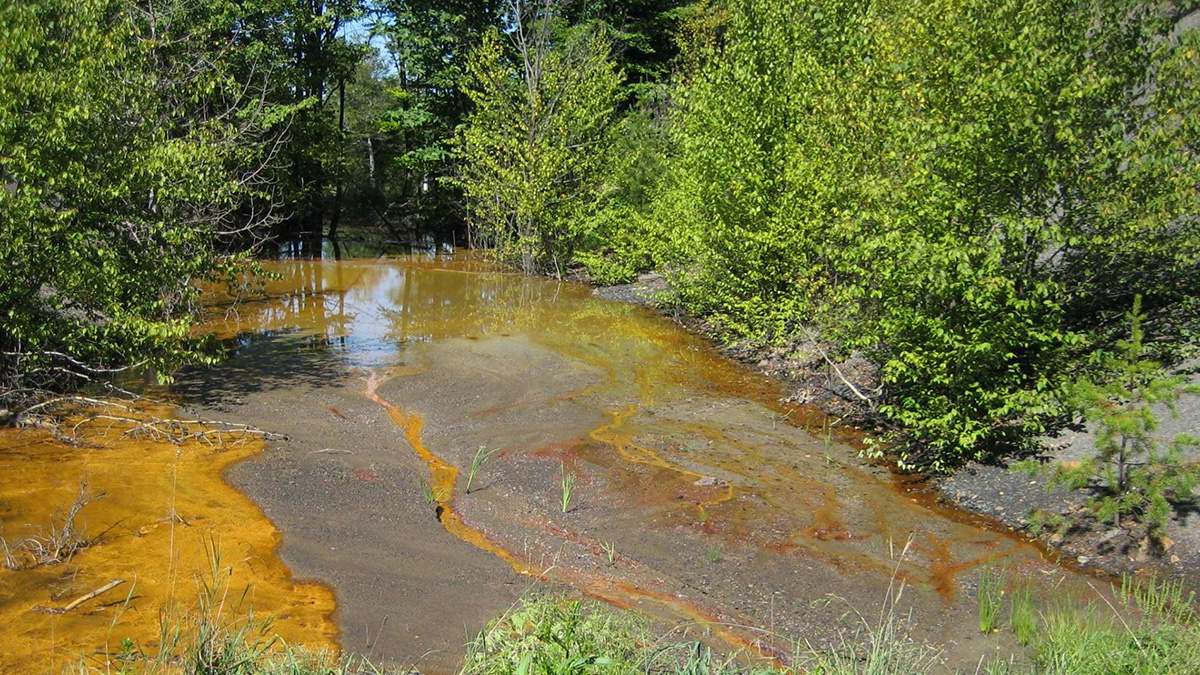A protein sensor developed by researchers that glows green when it encounters the rare earth element terbium could spur progress toward rare earth element mining in acid mine drainage in the United States.
The tool is the first luminescence-based sensor to quantify terbium at extremely low levels in an acidic, complex environmental sample. If commercialized, it could equip prospectors with the ability to search out the economically important element in abandoned mine tailings.
Rare earth elements are essential components in wind turbines and electric vehicles. Technologies to mine low-grade sources of rare earths—such as coal by-products, electric waste, and mine effluents—are attracting federal research dollars in the United States.
“It’s really a pretty simple method, and it has a sensitivity that is similar to the state of the art.”
“It’s really a pretty simple method, and it has a sensitivity that is similar to the state of the art,” said chemist Joseph Cotruvo at Pennsylvania State University, who developed the sensor with two others. The tool, which is still in research and development, performed as well as highly accurate laboratory instruments but would be faster and easier to operate.
“If the sensor can be mass-produced or reused, that would go a long way towards lowering the characterization costs for domestic rare earth production,” said Scott Crawford, a contractor for the National Energy Technology Laboratory (NETL) in Pittsburgh who was not involved in the development of the sensor. Increasing rare earth production in the United States is crucial to the country’s economic, environmental, and national security, he said.
Other researchers are also developing novel ways to sense rare earths. Researchers from NETL have tested fiber-optic sensors in liquid, and scientists at Idaho National Laboratory are working on a sensor using luminescent detection.
Illuminating Terbium
The new sensor comes from a protein discovered in the bacterium Methylorubrum extorquens, which lives in soils, on plants, and in other environments. The sensor could be used as part of a device to alert field technicians when terbium appears in acid mine drainage.
The protein lanmodulin selectively detects terbium, even in the presence of other rare earths or heavy metals dissolved in a solution. The researchers used tryptophan, a photosensitizer that absorbs light more efficiently than terbium, to transfer energy to terbium to excite it. Terbium then emits light at several wavelengths, the most intense being a greenish light at 545 nanometers. The luminescence grows more intense with more terbium present.
“Terbium is actually one of the most valuable rare earths, and it’s been deemed one of the five rare earths that are most economically critical.”
The sensor worked well when tested on acid mine drainage from the Lower Kittanning coal seam, even with low levels of terbium (on the order of parts per billion), a highly acidic solution, and in the presence of high concentrations of other rare earths and heavy metals.
The discovery was “really exciting, because terbium is actually one of the most valuable rare earths, and it’s been deemed one of the five rare earths that are most economically critical,” said lead author Emily Featherston, a chemistry doctoral candidate at Pennsylvania State University. The team published its results in the Journal of the American Chemical Society.
“This work represents a significant advancement in the field of rare earth detection,” said Crawford. “The sensor must be extraordinarily selective, akin to finding the proverbial needle in a haystack, binding specifically to rare earths and not to other elements in the sample.”
A limitation of the sensor is that metals must be in a liquid solution to be detected—the UV light can get blocked by solids, said Cotruvo. He hoped the sensor will be fully developed within 5 years and engineered to detect other valuable rare earths as well.
From Waste to Revenue
Currently, the U.S. Department of Energy (DOE) is funding more than 30 projects to source rare earth elements from coal mining and its waste. Coal ash, refuse rock, young lignite coal, sludge, and acid mine drainage are treasure troves of rare earth elements, but the technology needed to extract the valuable materials has yet to hit the commercial market.
Forty hard-rock mines in the United States produce 17–27 billion gallons of polluted water annually.
Acid mine drainage forms from the outflow of water from subsurface mines. Sulfur-bearing minerals in the rock turn water flowing by it acidic. In turn, the acidic water leaches heavy metals (including rare earths) from the rock. The highly corrosive water threatens aquatic life and water supplies.
Forty hard-rock mines in the United States produce 17–27 billion gallons of polluted water annually, according to the environmental nonprofit Earthworks in 2013.
But converting the waste into revenue has become a priority of DOE and NETL. In a report to the U.S. Congress in 2017, the groups said that two coal and coal ash areas in the United States could supply millions of tonnes of rare earth elements, which is well above the domestic demand of 100,000 tonnes annually.
In recent years, China has produced and supplied an average of 90% of global rare earth elements, according to the U.S. Geological Survey. In 2019, the country threatened to curb supply during trade tensions with the Trump administration.
—Jenessa Duncombe (@jrdscience), Staff Writer

